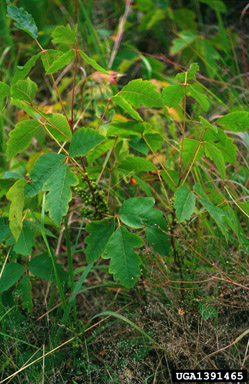 There are undoubtedly a wide variety of pretty plants along the Smith Mountain Lake shoreline. Some of those shiny green leaves could cause those who come in contact with them a massive amount of discomfort. Poison Oak is one such plant.
There are undoubtedly a wide variety of pretty plants along the Smith Mountain Lake shoreline. Some of those shiny green leaves could cause those who come in contact with them a massive amount of discomfort. Poison Oak is one such plant.
I have heard it said that there is no such thing as Poison Oak, though I know those who have been “bitten” by it can grow somewhat vehement about the issue. My Dad was a park ranger and even having grown up all my life loving the great outdoors, I don’t remember learning to identify this plant or even hearing much about it. However, according to Wikipedia (http://en.wikipedia.org), an erect shrub called Poison Oak bearing 3 leaves that resemble White Oak Tree leaves, does indeed exist and can cause contact dermatitis.
Atlantic Poison Oak (pictured at the top) can be found in our part of the country. The leaves of the plant tend to be somewhat fuzzy (though I don’t recommend touching them to find out) and turn orange or yellow in the fall. The plant also has a small yellow or greenish berry in certain seasons. All parts of the plant contain the urushiol oil which causes allergic reactions in many. 
Often the cause of a rash after contact with poison oak is fingernails, clothes, or other things that came in contact with the plant oil and did not get thoroughly washed. If this is the case, after about 24 hours a rash may occur and appear to spread during the next few days. In actuality, the only way the rash can spread is from further contact with the urushiol oil, not the fluid in the blisters or scratching them. Areas of skin that got a smaller dose of the oil may take longer to react and thus appear to have spread from the first rash occurrence. For most people, the rash will have run its course in one or two weeks even without treatment other than regular washing.
The best treatment for poison oak, just like all the poison plants, is immediate washing with soap and water to remove the oil from the skin, clothes, tools, etc. If the area is washed well before the oil bonds with the skin, no allergic reaction will occur. Other possible remedies include Burts Bees Poison Ivy Soap, homeopathic remedies such as Rhus Tox, aloe vera, Burows Solution, and other over-the-counter products from your local health food store or drug store. Check with your doctor of course if you suffer from severe allergies to this plant.
Thanks to David J. Moorehead and John D. Byrd for the use of their pictures, and to Wikipedia (http://en.wikipedia.org) for much of this information.
If you would like to identify a rash you picked up in the woods or while doing some backyard work, you can look at various rash pictures on Dr. Hardin’s website or at www.dermnet.com.

